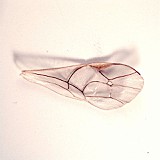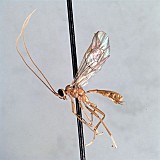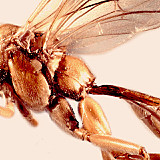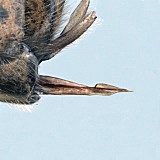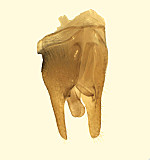Clypeus with ventral margin thick and mostly blunt medially; weakly toothed laterally in females of some species, usually less so in males, ventral margin appearing weakly concave in specimens where lateral tooth evident, otherwise varying from truncate to weakly convex; epistomal sulcus very weak, barely perceptible in some specimens. Malar space absent or nearly so. Mandible with ventral tooth longer than dorsal tooth. Ocelli large, lateral ocellus longer than distance between ocellus and eye. Palps and antennae long; maxillary palps longer than height of head; female antennae longer than body; first flagellomere with small tyloid containing 15 or fewer sensilla. Hypostomal carina joining occipital carina well before base of mandible; occipital carina complete. Dorsal end of epicnemial carina distant from anterior margin of mesopleuron. Notaulus varying from weakly impressed on anterior declivity to absent. U-shaped groove very distinct between propodeum and metanotum in lateral view; pleural carina usually complete, well-developed (Fig. 2), but weak, incomplete (absent medially) in one of the specimens examined; propodeal carinae varying from completely absent or nearly so in most species (Fig. 2) to well developed in
A. perilissoides, which has a pair of median longitudinal carinae forming a parallel-sided, rectangular areola and sometimes with a complete posterior transverse carina. Apex of mid tibia with small tooth similar to fore tibia in at least some species; apex of hind tibia with well-developed comb; posterior hind tibial spur at least 7x longer than maximum width at base; tarsal claws completely pectinate. Fore wing areolet present; Rs+2r arising near middle of stigma; 2-1A bulging posteriorly in middle of first subdiscal cell (Fig. 3), the bulge usually thickened or tuberculate. Hind wing with first abscissa of CU1 quite variable, either distinctly longer than 1cu-a (rare), nearly equal in length to 1cu-a (common), or distinctly shorter than 1cu-a (common). T1 (Fig. 2) long, slender, without dorsal carinae, dorsal surface weakly to moderately arched; no median basal depression at dorsal tendon attachment; dorsal-lateral carina extending through spiracle to apex of T1; glymmae on each side meeting on the midline posterior to dorsal tendon attachment, large, deep, separated at midline by translucent partition. T2 thyridium absent; short longitudinal carina extending less than half distance towards T2 spiracle from base; laterotergites of T2 and T3 completely separated by creases. Ovipositor straight, short, broad, with deep subapical notch (Fig. 4); ovipositor sheath rounded and weakly pointed apically. Male parameres weakly excavated medially, attenuate apically to form short, slender, rounded projections, these never as slender and pointed as in Mesochorinae and some Neurogenia; aedeagus rounded and weakly clubbed distally, with a short, thick, ventral spine on each side in some species (Fig. 5).
The known species are slender, long-legged, and pale yellow-orange with a black ocellar area.

